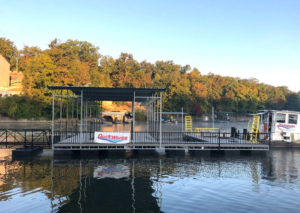Gutter Cleaning involves removing leaves, twigs, dirt, and other debris from your gutters to prevent clogs and ensure that rainwater flows smoothly away from your property. It’s an important part of home maintenance that helps protect your roof, foundation, siding, and lawn from damage.

Before climbing a ladder to clean your gutters, wear sturdy shoes and use gloves. It’s also a good idea to have a spotter for the ladder so you don’t fall. Contact Gutter Cleaning Summerville, SC for professional help.
Gutter cleaning ensures proper water flow from your roof and helps avoid the accumulation of excess moisture that can damage shingles and cause leaks. This prevents the need for premature replacement and saves money in the long run.
Regular gutter cleaning also decreases the amount of debris that can get into your roof. This reduces the risk of pest infestation and other issues that can impact your home’s structure. In addition, it keeps your home looking clean and beautiful.
Keeping your gutters cleaned on a regular basis also helps to prevent damage to the surrounding landscaping, driveways and walkways. If the water from clogged gutters pools on these surfaces, it can erode them and create cracks in the foundation of your home.
If you live in an area with a lot of trees, your gutters may need to be cleaned four times a year to keep them from clogging and damaging the property. Gutter cleaning also protects your roof and home from damage caused by ice dams.
The best time to clean your gutters is in the spring and fall, before and after the leaves fall. Then, the job can be done in less time and you won’t have to worry about dealing with the resulting mess.
A clogged gutter can lead to leaks, damage to your roof, and stained siding. In addition, it can cause erosion of the soil around your home’s foundation, causing cracks and shifting that could threaten the integrity of your foundation.
Clogged gutters can also create mold and other organic growth on your walls, shingles, and roof. The resulting damage can also lead to expensive repairs and a reduced lifespan for your roof.
The benefits of cleaning your gutters are many, but the task is not always easy. It requires a ladder, cleaning supplies, and safety gear. It’s important to set up the ladder on stable, sturdy ground and use a spotter to assist with climbing and repositioning it as needed. It’s also important to wear sturdy shoes and clothing that are meant for working outdoors. Lastly, it’s a good idea to invest in a safety harness to help protect against falls that could result in serious injury or even death.
Decreases Risk of Damage to Your Foundation
Gutter cleaning ensures rainwater is directed away from the foundation of your home, minimizing moisture buildup that can lead to cracks and structural instability. This prevents costly repairs and safeguards the value of your property.
Regular gutter cleaning also helps to preserve your roof, preventing moisture damage and premature shingle wear that can lead to expensive replacement costs. Proper drainage also allows for increased air circulation, reducing heat buildup that can warp and damage roofing materials.
Neglected gutters create a damp environment that attracts a variety of pests, including mosquitoes and rodents. These pests are carriers of diseases that pose health risks to your family. In addition, their chewing and burrowing habits can also cause significant damage to your foundation. Gutter cleaning ensures your gutter system is free of debris, reducing pest infestation and protecting your home from structural damage.
A professional gutter cleaning service uses a variety of tools to ensure a thorough job. They use high-powered handheld blowers to remove smaller particles from the gutter, as well as extension poles and powerful air blowers to tackle debris caught in roof valleys and behind chimneys. In addition, they use specialized equipment such as ladder safety straps and harnesses to ensure a safe work environment. They also use a hose to rinse off the gutters and wash down finer debris that is difficult to reach with a broom or rake. They begin at the bottom of each section of gutter, and work their way up to the top, checking for signs of clogging along the way. They also use a tarp to cover their workspace, and wear gloves and goggles for added protection.
Decreases Risk of Mold Growth
Gutter cleaning keeps water away from your house’s walls and foundation, reducing the risk of moisture damage and the resulting mold and mildew growth. These problems can lead to costly repairs and deterioration of the paintwork on the exterior of your home. Consistent gutter maintenance prevents these issues from developing and preserves the value of your home’s facade.
Clogged gutters allow water to back up and seep into your roof, walls, and foundation, causing extensive damage that can be difficult and expensive to repair. In addition, mold and mildew thrive in damp environments, making clogged gutters the perfect breeding ground for these harmful organisms. Regular gutter cleaning minimizes the buildup of water and eliminates the conditions that encourage mold and mildew, preserving the structural integrity of your home’s exterior and protecting your family from health risks.
In addition, standing water in clogged gutters creates the perfect habitat for pests like mosquitoes and rodents. Mosquitoes breed in stagnant water and can become a serious health concern for homeowners, while rodents such as rats look for shelter in debris-filled gutters. Regular gutter cleaning eliminates these nesting grounds and reduces the risk of pest infestations around your home.
Gutter cleaning also improves roof ventilation, reducing the risk of heat buildup that can warp shingles and shorten the lifespan of your roofing materials. Additionally, gutter cleaning can reduce the risk of ice dams, which form when melting snow refreezes at the eaves of your home’s roof. Regular gutter cleaning, especially before winter, can prevent these dangerous ice dams from forming and causing damaging leaks throughout your home’s interior and exterior.
In addition to performing thorough physical cleanings of the entire gutter system, a good gutter service will also include application of eco-friendly biocides and mold removers to the interior surfaces of your gutters. This chemical treatment effectively eliminates existing mold spores and inhibits future growth, protecting your gutters and ensuring the safety of your home’s interior and exterior. Taking these preventative steps is a smart investment that will protect your property’s value and ensure the longevity of your roof and home’s paintwork.
Decreases Risk of Damage to Your Home’s Appearance
Gutters are important for protecting your home’s walls, foundation, and landscape from water damage. They do this by directing rainwater away from your home, preventing it from seeping into cracks and crevices where mold, rot, and other issues can develop. However, if your gutters become clogged with leaves, twigs, dirt, and debris, they cannot perform their job properly. This can lead to many issues including leaks, wood rot, and water stains on your siding, roof, and foundation. Gutter cleaning is a simple way to prevent these problems and keep your home looking its best.
When a gutter becomes full of leaves, twigs, and debris, it becomes the perfect breeding ground for pests. These unwelcome guests can cause significant structural and health issues for your home, including a risk of disease, infestations, and structural damage. Regular gutter cleaning eliminates the breeding grounds for these pests, keeping them from gaining access to your home and posing a threat to your family’s health.
While a clogged gutter might not seem like a big deal at first, it can quickly become an issue that requires costly repairs. If left unchecked, overflowing water from a clogged gutter can force itself under the roof shingles, causing leaks, rot, and water stains on the wall and ceiling of your home. Clogged gutters can also lead to mold and mildew in the attic and infiltrate the foundation, potentially causing further damage and costly repairs.
Gutter cleaning is an easy and affordable task that can be performed by a homeowner, or a professional. Before beginning, it’s a good idea to clear the workspace and move any obstacles that might interfere with your work. Once the area is clear, you can begin by removing any large debris from the gutter with your hands or a rake. You can then use a garden hose or pressure washer to break up any remaining clogs and flush out the gutter. Once all visible debris is removed, the rest of the gutter can be cleaned with a leaf blower or wet/dry vac. For larger jobs, it may be a good idea to hire a professional gutter cleaner.








